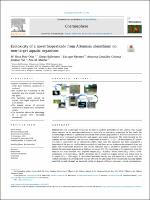Por favor, use este identificador para citar o enlazar este ítem:
https://repositorio.usj.es/handle/123456789/367
Registro completo de metadatos
| Campo DC | Valor | Lengua/Idioma |
|---|---|---|
| dc.contributor.author | Pino Otín, Rosa | - |
| dc.contributor.author | Ballestero Fernández, Diego | - |
| dc.contributor.author | Navarro Rodríguez, Enrique | - |
| dc.contributor.author | González-Coloma, Azucena | - |
| dc.contributor.author | Val, Jonatan | - |
| dc.contributor.author | Mainar, Ana M. | - |
| dc.date.accessioned | 2020-04-01T08:10:32Z | - |
| dc.date.available | 2020-04-01T08:10:32Z | - |
| dc.date.issued | 2018-10-18 | - |
| dc.identifier.citation | Pino-Otín, M. R., Ballestero, D., Navarro, E., González-Coloma, A., Val, J., & Mainar, A. M. (2019). Ecotoxicity of a novel biopesticide from artemisia absinthium on non-target aquatic organisms. Chemosphere, 216, 131-146. doi:10.1016/j.chemosphere.2018.09.071 | es_ES |
| dc.identifier.issn | 0045-6535 | es_ES |
| dc.identifier.uri | https://repositorio.usj.es/handle/123456789/367 | - |
| dc.description.abstract | Biopesticides are increasingly being used to replace synthetic pesticides for pest control. This change raises concern for its environmental impacts, especially on non-target organisms. In this study, the ecotoxicological effects of a potential nematicide from Spanish populations of Artemisia absinthium (var. Candial) were evaluated on freshwater and aquatic non-target organisms. The study focused on the aqueous extract (hydrolate), the principal component of which ((−) -(Z) −2,6-dimethylocta-5,7-diene-2,3-diol) is responsible for its nematicidal effect. Until now, the hydrolate has been considered a byproduct of the process used to obtain essential oils, and there are no studies on its ecotoxicity from any plant with biopesticide properties. Our results indicated that A. absinthium hydrolate caused acute toxicity for non-target organisms at dilutions as low as 0.2%. The sensitivity of the organisms, from the most to the least sensitive, was: Daphnia magna (LC50 = 0,236%) > Vibrio fisheri (LC50 = 1,85%) > Chlamydomonas reinhardtii (LC50 = 16,49). Moreover, the A. absinthium organic extract was highly toxic to D. magna (LC50 = 0,093 mg/L). A. absinthium hydrolate toxicity was also tested on a natural river microbial community. Bacterial growth was not affected; the physiology of the community was only slightly modified, namely through an increased ability to degrade different substrates, mainly carbohydrates. This study provides for the first time an exhaustive assessment of the environmental exposure of a plant-derived biopesticide and shows that these products may cause a broad range of toxicity on non-target aquatic organisms. | es_ES |
| dc.format.mimetype | application/pdf | es_ES |
| dc.language.iso | eng | es_ES |
| dc.publisher | Elsevier Ltd | es_ES |
| dc.relation | Ministerio de Economía y Competitividad (CTQ2015-64049-C3-2-R) Gobierno de Aragón-FSE (Grupo GATHERS E39_17R) Cátedra NOVALTIA | es_ES |
| dc.rights | Atribución 4.0 Internacional | * |
| dc.rights.uri | http://creativecommons.org/licenses/by/4.0/ | * |
| dc.subject | Biopesticida | es_ES |
| dc.subject | Artemisia absinthium | es_ES |
| dc.subject | Ecotoxicity | es_ES |
| dc.subject | Hydrolate | es_ES |
| dc.title | Ecotoxicity of a novel biopesticide from Artemisia absinthium on non-target aquatic organisms | es_ES |
| dc.type | info:eu-repo/semantics/article | es_ES |
| dc.subject.unesco | Agricultura | es_ES |
| dc.identifier.publicationfirstpage | 131 | es_ES |
| dc.identifier.publicationlastpage | 146 | es_ES |
| dc.identifier.doi | https://doi.org/10.1016/j.chemosphere.2018.09.071 | es_ES |
| dc.rights.accessrights | info:eu-repo/semantics/openAccess | es_ES |
| Aparece en las colecciones: | Artículos de revistas | |
Ficheros en este ítem:
| Fichero | Descripción | Tamaño | Formato | |
|---|---|---|---|---|
| Ecotoxicity of a novel biopesticide from Artemisia absinthium.pdf | 2,85 MB | Adobe PDF |  Visualizar/Abrir |
Este ítem está sujeto a una licencia Creative Commons Licencia Creative Commons

